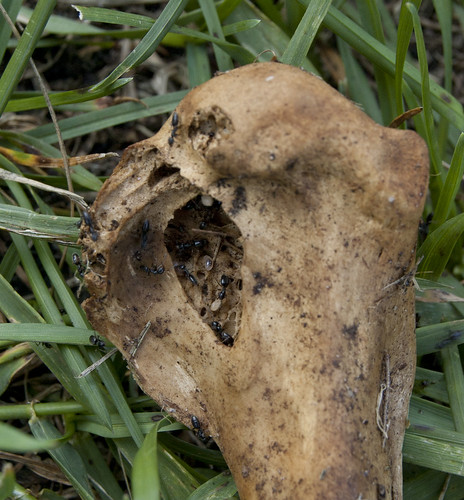
... and it took us both a moment to realize that there was an ant colony inside this bone. The ants, having sensed their home had been disturbed, were evacuating, taking care to retrieve their eggs and young.


From what I could see, the set-up inside was amazing. The eggs and pupae were tucked into the calcium cavities of the bone, and the entry/exit to the colony was a large hole (as seen in the photograph above). After we had observed the ants for some time, Steph returned the bone to where she had found it, taking care to put it back in the same position.
How interesting is it that an entire colony of ants calls a rather small bone its home? I've seen spiders build their webs inside the brain cavities of skulls -- and I've heard the same for wasp nests (hopefully I'll never see something like this in-person) -- but I've never seen such a thing with ants. It's pretty incredible that this insect (which is almost always associated with creating complex tunnels in the soil) has used a bone for this purpose: not for food, but for a home.
What other creatures use the remains of animals as a place not to get nourishment, but to live?
How interesting is it that an entire colony of ants calls a rather small bone its home? I've seen spiders build their webs inside the brain cavities of skulls -- and I've heard the same for wasp nests (hopefully I'll never see something like this in-person) -- but I've never seen such a thing with ants. It's pretty incredible that this insect (which is almost always associated with creating complex tunnels in the soil) has used a bone for this purpose: not for food, but for a home.
What other creatures use the remains of animals as a place not to get nourishment, but to live?




That is pretty amazing. What a perfect find for this blog!
ReplyDeleteIt makes my heart twitch a little that they were evacuating and taking their eggs. I just imagine tiny little ants in a panic. "SAVE THE CHILDREN!"
I hope the ants were able to find their way back to their nest! They were very frantic. Ants do leave scent trails, so they (and their babies) hopefully made it back just fine.
ReplyDelete